Andy Bateman a qualified Winter Mountain Leader of 20yrs experience gives his winter gear thoughts relative to the forecast for the Cairngorms Fri 27 Oct – Thu 2 Nov, 2017.
We are now approaching the end of October and the first bout of proper wintry weather has swept across our hills. There should be another one later this week.
Up to this point, there has been a notable lack of frosts so the ground is going to be relatively warm. Forecast precipitation doesn’t look as if it is going to amount to much. It looks unlikely you will be facing full on conditions. Having said this they are predicting high winds, blizzards and a wind-chill down to -10 deg C for the highest tops so it’s most definitely time to review the kit in your rucksack.
It’s worth noting also: a forecast is only a forecast. Things can change and so in turn can my thoughts below. It is of course imperative that an updated forecast is sort on the evening or morning prior to setting out.
At this point in time the crampons are unlikely to be much benefit. They might make it into the boot of the car just in case but there could well be a chance of fresh dusting of lying snow so proper winter boots are most definitely a consideration (B2 or B3). Where you have the ground covered in a thin layer of fresh snow stiff winter boots rather flexible boot with a flexible crampon would be the most likely the preferred choice.
Although no substitute for proper crampon in full winter conditions in these conditions [amazon_textlink asin=’B0172G4S7U’ text=’Kahtoola microspikes’ template=’ProductLink’ store=’1603-8102-0783′ marketplace=’UK’ link_id=’e836781c-bd95-11e7-b79a-19be9ad20467′] might be an idea.
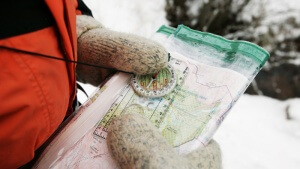 Winter walking in the Cairngorm Mountains, Aviemore, Scotland.
Winter walking in the Cairngorm Mountains, Aviemore, Scotland. As is the case at any time of the year but especially now, the body is likely to chill pretty quickly once you come to a stop. That extra thick fleece or an overlay jacket for when you’re not active most definitely can justify its place in the rucksack now.
Hand could also benefit from gloves being thicker. It’s time to be swapping the summer gloves for the winter ones. Another thing to bear in mind is to make sure the rest of your body is adequately insulated. If your torso is warm you will be far more resistant to getting cold hands. Think how the body conserves the core temperature – it restricts the circulation to the extremities e.g. hands. Often folks say it’s just their hands that feel cold and only deal with the affected area. You torso won’t feel cold because the body has compensated but that’s not to say hands won’t benefit from an added layer to the torso.
Warmer leg ware is also a consideration. It might be a case of wearing leggings/long johns
To state the obvious, eyesight is vitally import in the mountains. Trying to navigate directly into a blizzard can be at best purgatory, at worst nigh impossible. Even relatively light winds can cause snow to hit you directly on the eye ball. It’s not nice. In our damp cold mountain climate condensation is an issue so make sure you equip yourself with some proper anti fog (double lenses) ski goggles. A pair of safety goggles out of a workshop just doesn’t ‘cut the mustard’.
You of course you should be carrying these at any time of the year but now you maybe wearing them for their windproof as much as their waterproof qualities. A jacket with an integral hood is also a must.
It’s now getting dark at around 5:30pm and the clocks are about to go back. The days are now a lot shorter than they were a few months ago. Possibly an earlier start and less ambitious plans are the order of the hill day but most certainly a head torch with fresh batteries should be part of your kit. It should also be one that’s strong enough to navigate in the dark. A powerful beam makes a massive difference.
If I’m not taking proper crampons I may well at least be thinking about having at least one axe in the party just in case. The forecast is for 2 periods of sub-zero temperatures both lasting around 24hrs so there could be some ice build up where there is seepage emerging from the ground.
We hope to see you out in the hills soon getting ready for the full on winter conditions. If you’re signed up for our newsletter you’ll shortly be invited to join us to bring in the New Year. See you then – hopefully with plenty of the white stuff on the hill!
We run winter skills courses and winter walking holidays in the Cairngorms and across Scotland. We are also specialists in winter expeditions, especially the snowhole. Please see our video below to entice you to join us … some dates only limited availability.
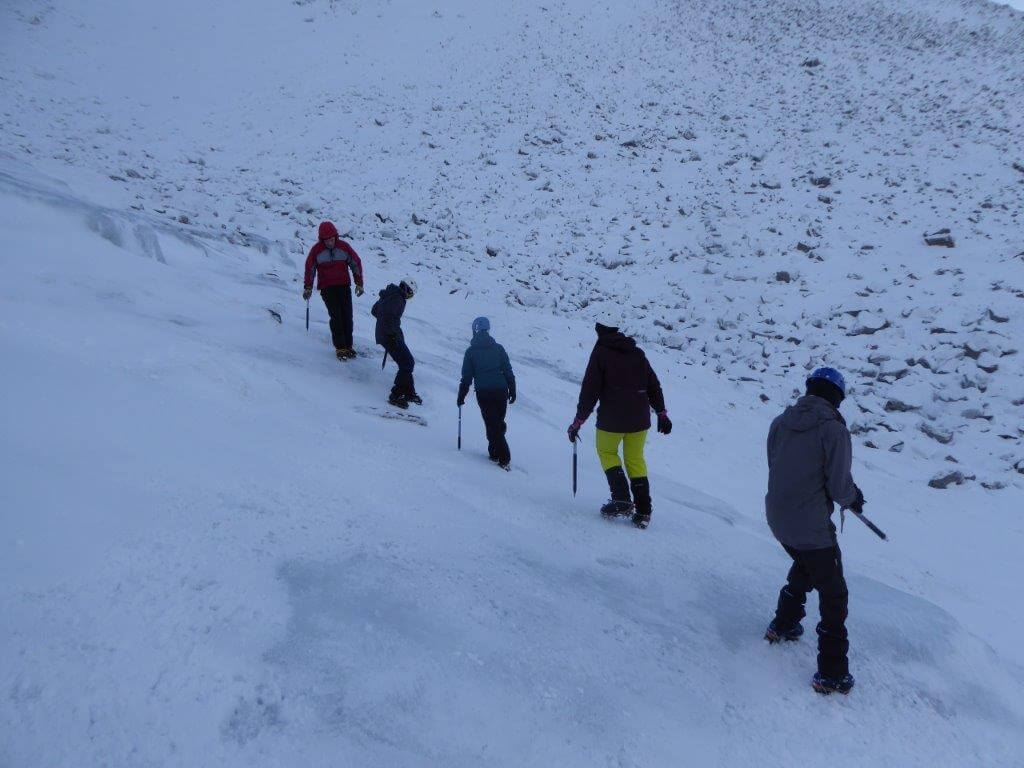
It’s now middle of November and winter in our mountains is knocking at our door. As the Atlantic storms pass our area the arctic air is drawn into their wake. With each passing front, the weather can be extremely changeable. It may be weeks yet before winter conditions are in full nick for full on winter walking, but sudden blizzards on the high tops are now common place – meaning the ill prepared can be easily caught out. Scot Mountain Holidays guide and instructor Andy Bateman takes us through some of the considerations over and above the essentials of ice axe and crampons in transitioning from autumn in winter trekking conditions.
It is prudent to carry a head torch at most times of year, but especially in the case of winter. The days are short and even a minor delay can make the difference between coming off the hill in the daylight and dark. Don’t go without!
In addition, make sure the batteries are fresh so your torch is working at full power. Carry spares too but try to avoid fumbling about to change batteries in a blizzard!
Consider upgrading your head torch to a more powerful model . Remember you may be trying to discern navigational features both in the dark and in the fog.
The stiffness of the winter boot is an integral part of ensuring crampons can be securely attached to your feet. This being said, bunging crampons is not a “fix all” and the winter boot is as much a tool on your foot as the ice axe is in your hand. You need adequate stiffness to kick steps comfortably and efficiently into hard snow. Without it, it will be difficult to execute the technique of front pointing safely.
Proper winter boots are also better insulated. If you’re thinking about buying a boot for the winter go for at least a B2. A B1 boot may be fine for a serious summer glacier trek in the Himalayas, but they don’t come up to the mark when it comes to winter in the Scottish mountains.
Check the state of your soles. It’s those sharp right angled edges that help to prevent slipping and allow you to kick steps.

Which boots to choose for winter?
These are an absolute must and in our damp mountain climate they need to be anti-fog (double lenses). It may be uncomfortable – but not impossible – navigating into driving rain, but don’t underestimate how painful this is once precipitation turns solid. It can be literally impossible to see. Your sight is of vital importance so don’t skimp on the goggles and head torch.
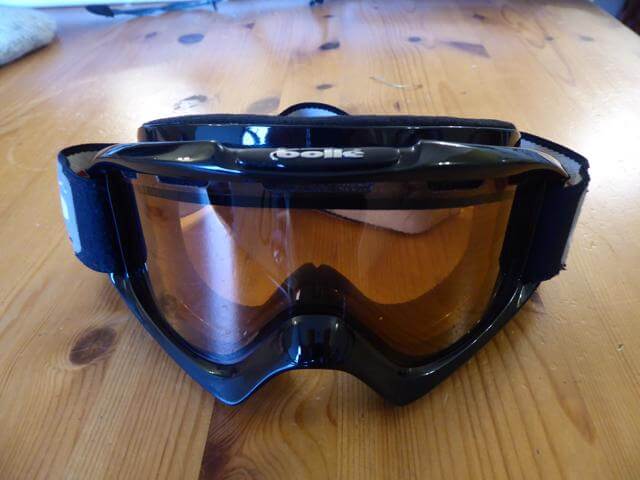
Pack that extra warm layer. The ambient temperature at 1000m rarely drops below -10 degrees C but don’t underestimate how cold it can feel. A weak winter sun, the damp air and often a high wind chill all conspire to make the British mountains one of the worst places for hypothermia. You can chill quickly when you stop moving. A really thick fleece or over layering jacket is ideal. Be cautious about wearing duvets jackets under other garments – they can loose their loft and hence insulation.
Make sure you gloves are warm enough for winter walking … i.e. they must be proper thick gloves. Not only do your hands have a very large surface area compared with their volume but also the body will reduce the circulation to them to conserve the core temperature – no wonder they get cold! So if you do have cold hands don’t just think of putting on warmer gloves, but also an extra layer on your body.
Also remember if you do particularly suffer from cold hands, mitts are better at giving you the option of adding heat pads.
If you’re coming on a winter skills course or winter walking holiday with Scot Mountain Holidays please don’t hesitate to contact Andy if you have any further questions, an expert in optimal gear.
Andy will be publishing further blogs on the subject of preparing for winter over the forthcoming weeks. Keep your eyes open!
You can also take a look at our Winter walking holidays, Winter Skills courses and Full moon Snow-hole Expedition.
Whether you are caught in a white-out, needing to navigate trails or provide emergency first aid, it is imperative hikers are properly equipped on their Highland adventures. Otherwise we would rely too heavily on Mountain Rescue for preventative emergencies!
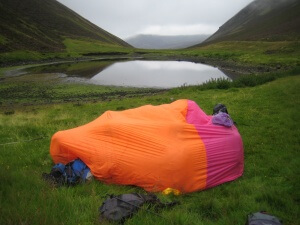 Keeping gear dry is a must. Photo courtesy of Complete Cairngorms participant, Alison Hedley
Keeping gear dry is a must. Photo courtesy of Complete Cairngorms participant, Alison HedleyHere in Scotland’s Highlands the terrain and weather can be deceptive as our tallest peak Ben Nevis is 1,345 metres. However, the tree line in Scotland begins around 6-800 metres. Higher winds and colder and changeable weather thus occur lower down in Scotland at the same severity. This means, effectively, the environment you get at 600 metres is the same at 3,000 metres in the Alps.
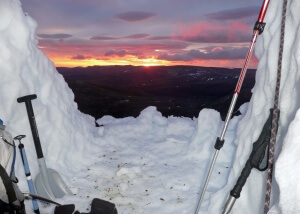 Some Full moon Snow-hole Expedition gear: snow shovel, ice axe, trekking pole, rope, rucksack
Some Full moon Snow-hole Expedition gear: snow shovel, ice axe, trekking pole, rope, rucksackTo protect ourselves from Scotland weather we prepare with the proper gear. Cioch Outdoor Clothing is a Scottish based manufacturer on the Isle of Skye, and along with being comfortable and durable they also provide excellent customer service.
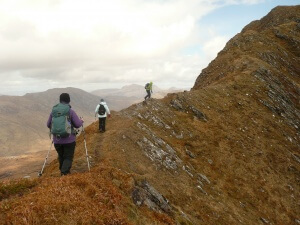 Wild Knoydart: walkers know the value of a good pack!
Wild Knoydart: walkers know the value of a good pack!Nikwax Analogy material made to measure by Cioch and Páramo clothing, an ethical manufacturer, are favourites of Andy. He values these for their waterproof and windproof properties, essential to weathering Scotland’s worst. Many are surprised by the severity of “wind chill”. (Wind chill is the effect of the wind in cold weather, which makes the actual temperature feel so much colder than the thermometer records.) Wind chill creates a high risk of hypothermia. Extra layers are a must.
 Andy in a Nikwax Analogy smock jacket by Páramo
Andy in a Nikwax Analogy smock jacket by PáramoKey features: never go without a map and compass, and pay special attention to foot care. Proper walking boots are essential. In general the heavier the boot, the more equipped you will be, and stiffer boots are best for dealing with snow.
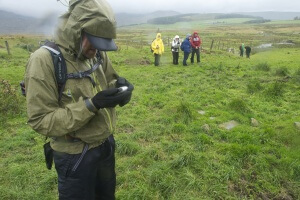 Scotland – ATTA – Adventure Travel World Summit; Spirit of the Cairngorms. Compass for navigation.
Scotland – ATTA – Adventure Travel World Summit; Spirit of the Cairngorms. Compass for navigation.How does Gore-Tex compare to its competitors? Do you need to splurge on expensive gear for a single trip? Our resident guide Andy Bateman is an expert in questions like these.
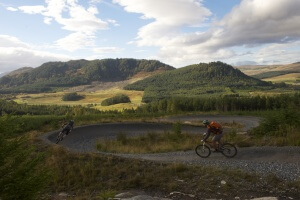 Scotland – ATTA – Adventure Travel World Summit; Spirit of the Cairngorms. A bike you can depend on
Scotland – ATTA – Adventure Travel World Summit; Spirit of the Cairngorms. A bike you can depend onWe provide advice on the kit you will need, because the best gear makes you forget the job it is doing, and leaves you to soak in your adventures instead.
All content © Copyright Scot Mountain Holidays 2025
Responsive web design by Summit Web Solutions